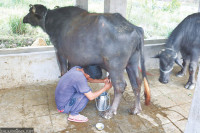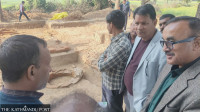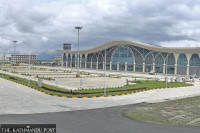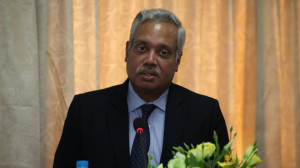National
Talking glaciers but forgetting floods
Experts say climate is talked about mostly by people who are unaffected by adverse impacts. Sufferers are ignored.
Post Report
While national and international guests and dignitaries of Sagarmatha Sambaad convened in Kathmandu to contemplate the impacts of climate change, some locals in Panauti Municipality of Kavrepalanchok district, around 32 kilometres from the capital city, were busy on Friday searching for a woman swept away by a local stream five days ago.
A flood in the stream, triggered by heavy rain, had swept away Renuka Giri, 33, a resident of ward 5 of the municipality, while she was returning home from work in the fields.
The local administration on Thursday also deployed police sniffer dogs to trace the missing woman, but to no avail. Now, efforts to find her have slowed down.
“Only a few local youths have been mobilised in search of the missing woman,” Binod Khatri, ward 5 chair, told the Post over the phone from Panauti. “We have never heard of such an incident in the past in this locality. The stream is just around three feet wide, and one can cross it in a stride even during the monsoon.”
Panauti residents are flabbergasted by the massive flood in the small stream during the pre-monsoon season that swept away a woman. The incident has also alarmed climate experts, as pre-monsoon rainfall caused death and destruction. Despite the fact that the monsoon is just around the corner, authorities concerned however have not started preparations for the looming disasters.
“Negligence and a lackadaisical approach are more dangerous than the disasters themselves,” said Madhukar Upadhya, a climate expert. “It seems we are more concerned about the snow melting than the impacts of looming disasters.”
Experts say the issue of climate change has become a topic of discussion among people mainly among those not affected by its adverse impacts and who show little concern for those who are.
“Our own experiences show that affected people do not get much relief from the discussions held in luxury hotels by spending huge amounts,” said Upadhya. “Like world politics, the climate itself is changing unpredictably. Relevant authorities should start preparations with a priority to protect the population from possible risks, prepare for the worst-case scenario, rescue the victims, and rehabilitate them.”
The monsoon season generally begins on June 13 in Nepal and ends on September 23.
Nepal is one of the world’s most vulnerable countries to the climate crisis and has witnessed extreme weather events over the past decade and a half. The weather has turned more unusual and destructive in the past couple of years.
Evidence suggests that the maximum temperature in Nepal is rising at a greater rate (0.056 degrees Celsius per year) than the global average of 0.03 degrees Celsius per year.
Experts say extreme weather events—excess rainfall in a short period, continuous rains for several days after the monsoon, dry spells, droughts, below-average precipitation, and above-normal winter temperatures—have become more frequent in Nepal.




 6.12°C Kathmandu
6.12°C Kathmandu














